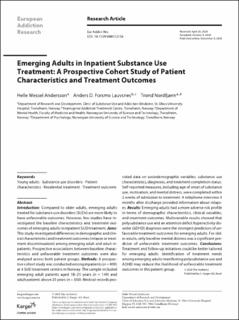| dc.contributor.author | Andersson, Helle Wessel | |
| dc.contributor.author | Lauvsnes, Anders Dahlen Forsmo | |
| dc.contributor.author | Nordfjærn, Trond | |
| dc.date.accessioned | 2021-02-16T09:19:10Z | |
| dc.date.available | 2021-02-16T09:19:10Z | |
| dc.date.created | 2020-10-09T10:25:01Z | |
| dc.date.issued | 2020 | |
| dc.identifier.citation | European Addiction Research. 2020, 1-10. | en_US |
| dc.identifier.issn | 1022-6877 | |
| dc.identifier.uri | https://hdl.handle.net/11250/2728264 | |
| dc.description.abstract | Introduction: Compared to older adults, emerging adults treated for substance use disorders (SUDs) are more likely to have unfavorable outcomes. However, few studies have investigated the baseline characteristics and treatment outcomes of emerging adults in inpatient SUD treatment. Aims: This study investigated differences in demographic and clinical characteristics and treatment outcomes (relapse or treatment discontinuation) among emerging adult and adult inpatients. Prospective associations between baseline characteristics and unfavorable treatment outcomes were also analyzed across both patient groups. Methods: A prospective cohort study was conducted among inpatients (n = 499) at 4 SUD treatment centers in Norway. The sample included emerging adult patients aged 18–25 years (n = 149) and adult patients above 25 years (n = 350). Medical records provided data on sociodemographic variables, substance use characteristics, diagnoses, and treatment completion status. Self-reported measures, including age of onset of substance use, motivation, and mental distress, were completed within 2 weeks of admission to treatment. A telephone interview 3 months after discharge provided information about relapses. Results: Emerging adults had a more adverse risk profile in terms of demographic characteristics, clinical variables, and treatment outcomes. Multivariable results showed that polysubstance use and an attention deficit hyperactivity disorder (ADHD) diagnosis were the strongest predictors of unfavorable treatment outcomes for emerging adults. For older adults, only baseline mental distress was a significant predictor of unfavorable treatment outcomes. Conclusions: Treatment and follow-up initiatives could be better tailored for emerging adults. Identification of treatment needs among emerging adults manifesting polysubstance use and ADHD may reduce the likelihood of unfavorable treatment outcomes in this patient group. | en_US |
| dc.language.iso | eng | en_US |
| dc.publisher | S. Karger Inc. | en_US |
| dc.rights | Navngivelse-Ikkekommersiell 4.0 Internasjonal | * |
| dc.rights.uri | http://creativecommons.org/licenses/by-nc/4.0/deed.no | * |
| dc.title | Emerging adults in inpatient substance use treatment: A prospective cohort study of patient characteristics and treatment outcomes | en_US |
| dc.type | Peer reviewed | en_US |
| dc.type | Journal article | en_US |
| dc.description.version | publishedVersion | en_US |
| dc.source.pagenumber | 1-10 | en_US |
| dc.source.journal | European Addiction Research | en_US |
| dc.identifier.doi | 10.1159/000512156 | |
| dc.identifier.cristin | 1838414 | |
| dc.description.localcode | The Author(s). Published by S. Karger AG, Basel. This is an Open Access article licensed under the Creative Commons Attribution-NonCommercial-4.0 International License (CC BY-NC) (http://www.karger.com/Services/OpenAccessLicense), applicable to the online version of the article only. Usage and distribution for commercial purposes requires written permission. | en_US |
| cristin.ispublished | true | |
| cristin.fulltext | original | |
| cristin.qualitycode | 1 | |

